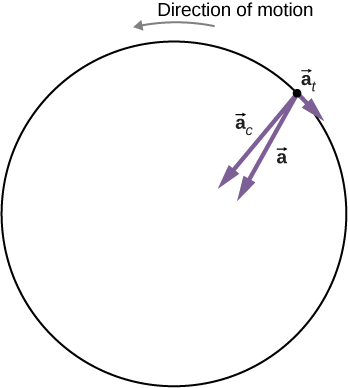| << Chapter < Page | Chapter >> Page > |
Therefore, the tangential acceleration is
The angular velocity at is
Thus, the tangential speed at is
We can now calculate the centripetal acceleration at :
Since the two acceleration vectors are perpendicular to each other, the magnitude of the total linear acceleration is
Since the centrifuge has a negative angular acceleration, it is slowing down. The total acceleration vector is as shown in [link] . The angle with respect to the centripetal acceleration vector is
The negative sign means that the total acceleration vector is angled toward the clockwise direction.

Check Your Understanding A boy jumps on a merry-go-round with a radius of 5 m that is at rest. It starts accelerating at a constant rate up to an angular velocity of 5 rad/s in 20 seconds. What is the distance travelled by the boy?
The angular acceleration is
. Therefore, the total angle that the boy passes through is
.
Thus, we calculate
.
Check out this PhET simulation to change the parameters of a rotating disk (the initial angle, angular velocity, and angular acceleration), and place bugs at different radial distances from the axis. The simulation then lets you explore how circular motion relates to the bugs’ xy -position, velocity, and acceleration using vectors or graphs.
Explain why centripetal acceleration changes the direction of velocity in circular motion but not its magnitude.
The centripetal acceleration vector is perpendicular to the velocity vector.

Notification Switch
Would you like to follow the 'University physics volume 1' conversation and receive update notifications?